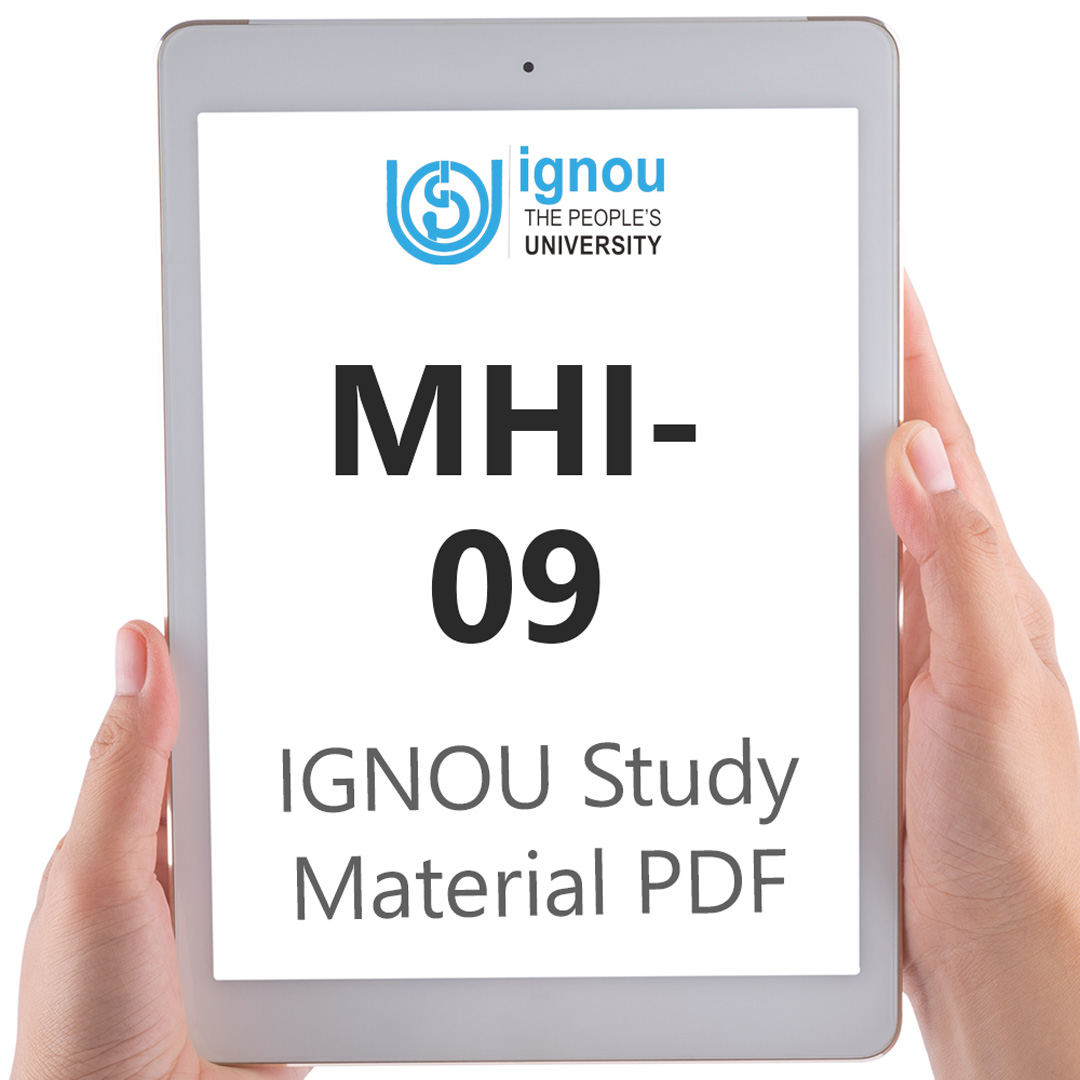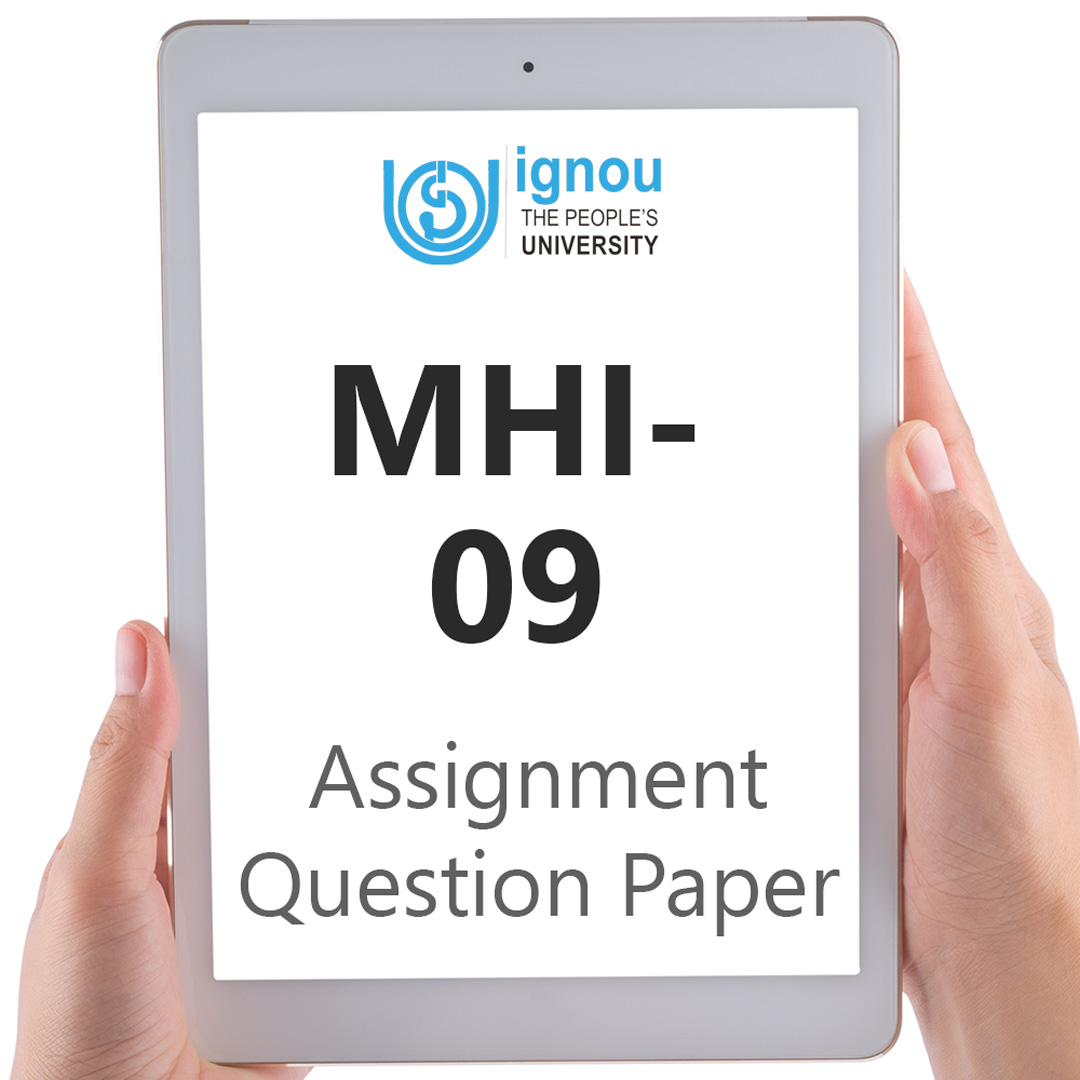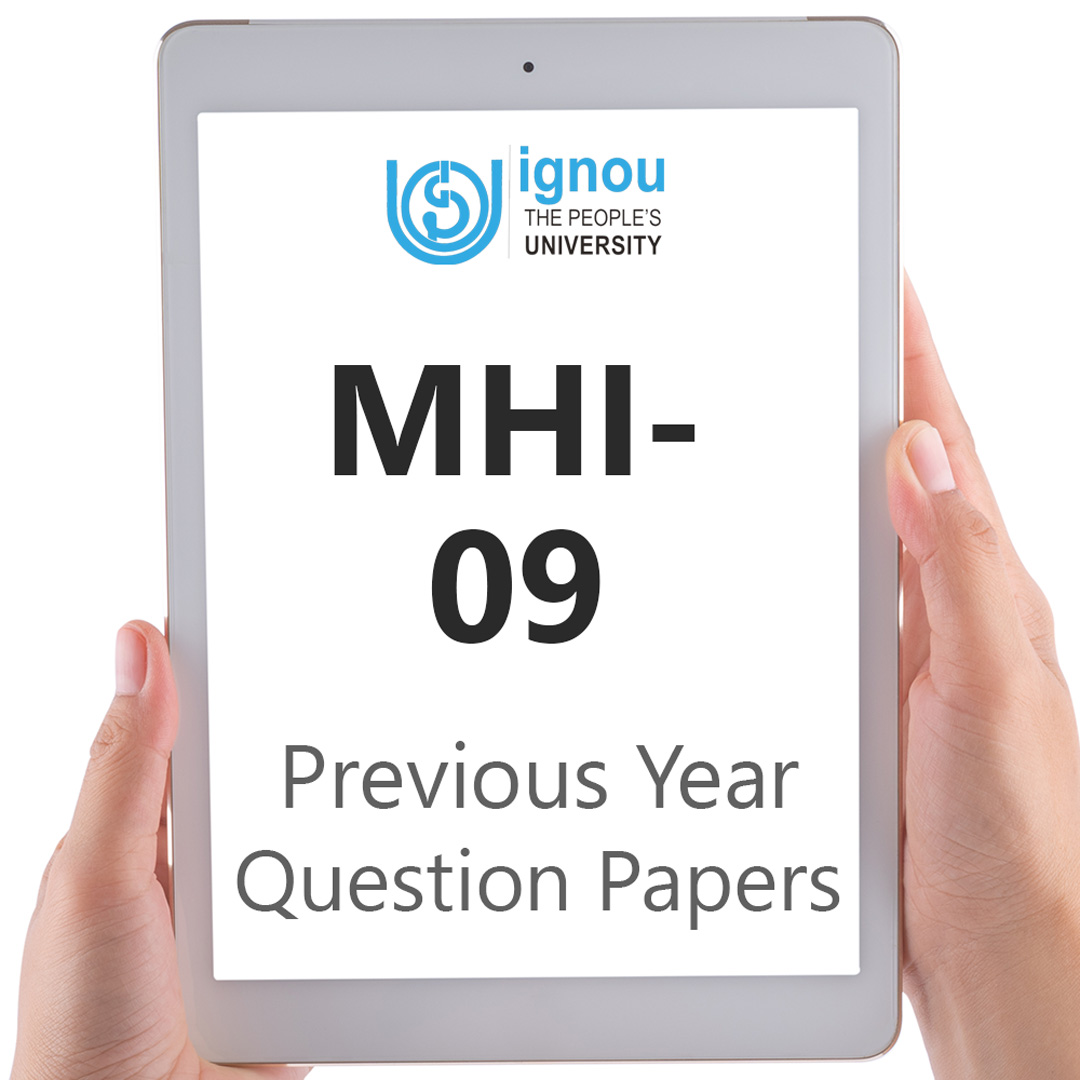If you are looking for MHI-09 IGNOU Solved Assignment solution for the subject Indian National Movement, you have come to the right place. MHI-09 solution on this page applies to 2023-24 session students studying in MAH courses of IGNOU.
MHI-09 Solved Assignment Solution by Gyaniversity
Assignment Code: MHI-09/AST/TMA/2023-2024
Course Code: MHI-09
Assignment Name: Indian National Movement
Year: 2023-2024
Verification Status: Verified by Professor
Note: Attempt any five questions. The assignment is divided into two Sections 'A' and 'B'. You
have to attempt at least two questions from each section in about 500 words each. All questions carry equal marks.
SECTION A
Q1) Describe the ideologies and activities of the revolutionary nationalists during the 1920s and 1930s.
Ans) The 1920s and 1930s were marked by the emergence of revolutionary nationalists in India who sought to challenge British colonial rule through ideological and political means. They were inspired by the nationalist fervour and the call for self-determination. Here are the ideologies and activities of the revolutionary nationalists during this period:
Ideologies
a) Non-Cooperation and Civil Disobedience: Influenced by Mahatma Gandhi's non-cooperation and civil disobedience movements, revolutionary nationalists believed in non-violent resistance as a means to achieve independence. They aimed to mobilize the masses and harness their collective strength against the British.
b) Socialism and Marxism: Some revolutionary nationalists were influenced by socialist and Marxist ideologies. They believed that India's economic exploitation under British rule could only be rectified through socialist principles. They envisioned a future India with equitable distribution of wealth and resources.
c) Complete Independence: Revolutionary nationalists were unwavering in their demand for complete independence from British colonial rule. They rejected any form of dominion status or limited autonomy and aimed for full sovereignty.
d) Secularism and Inclusivity: Many of these nationalists championed the values of secularism and inclusivity. They envisioned an independent India that respected the rights and cultures of all its diverse communities.
Activities
a) Mass Mobilization: Inspired by leaders like Mahatma Gandhi, revolutionary nationalists participated in mass movements like the Non-Cooperation Movement and the Civil Disobedience Movement. They organized protests, strikes, and boycotts to put pressure on the British government.
b) Underground Revolutionary Activities: A section of revolutionary nationalists believed that armed resistance was necessary to overthrow colonial rule. They formed secret societies and carried out activities like bombings, assassinations, and acts of sabotage against the British.
c) Publication of Revolutionary Literature: Revolutionary nationalists published newspapers, pamphlets, and journals to propagate their ideologies and expose British atrocities. These publications were instrumental in spreading awareness and mobilizing public opinion.
d) Formation of Political Parties: Some revolutionary nationalists joined or formed political parties, such as the Hindustan Socialist Republican Association (HSRA), which aimed to achieve independence through political means. Bhagat Singh, Chandrashekhar Azad, and Bhagwati Charan Vohra were prominent members of the HSRA.
e) Participation in International Forums: Revolutionary nationalists engaged with international organizations and forums to garner support for India's independence. They sought to build alliances with anti-imperialist movements and leaders worldwide.
f) Role of Women: Women played a significant role in revolutionary activities, both in non-cooperation movements and armed resistance. Leaders like Matangini Hazra and Kalpana Dutt were involved in various acts of protest and resistance.
g) Prison Struggles: Many revolutionary nationalists faced arrests and imprisonment. While in prison, they continued their struggle through hunger strikes and other forms of protest.
Q2) Analyse the successes and failures of the Civil Disobedience Movement.
Ans) The Civil Disobedience Movement, led by Mahatma Gandhi, was a significant episode in the Indian independence struggle. It began in 1930 and continued until 1934. The movement had both successes and failures, which can be analysed as follows:
Successes
a) Mass Mobilization: The Civil Disobedience Movement witnessed massive participation from various sections of society, including peasants, workers, students, and women. Millions of Indians joined the movement, making it one of the largest mass movements in the history of India.
b) Economic Impact: The movement disrupted the functioning of British institutions in India. Indians boycotted foreign goods, refused to pay taxes, and boycotted government schools and colleges. This had a significant economic impact on the colonial administration.
c) Salt March: One of the iconic events of the movement was the Salt March, where Mahatma Gandhi and his followers marched to the Arabian Sea to make their own salt in defiance of the salt tax imposed by the British. The march received international attention and inspired many.
d) Promotion of Self-Reliance: The movement promoted the idea of self-reliance and self-sufficiency. Indians started making their own salt, spinning their own cloth, and boycotting British products. This contributed to the idea of "swadeshi."
e) International Attention: The Civil Disobedience Movement garnered international sympathy and support. Many countries and individuals around the world admired the non-violent struggle led by Gandhi.
f) Political Milestones: As a result of the movement, the British government introduced the Government of India Act of 1935, which granted some limited provincial autonomy to India. This marked a significant step toward self-governance.
Failures
a) Repression and Arrests: The British government responded with harsh repression. Thousands of activists, including Gandhi, were arrested. The use of force led to many casualties, and the colonial authorities showed little willingness to negotiate.
b) Divisions within the Nationalist Movement: There were internal divisions within the Indian National Congress, particularly between those advocating non-violence and those endorsing more militant methods. This internal rift weakened the movement's unity.
c) Limited Concessions: While the Government of India Act of 1935 represented a political milestone, it fell short of full independence. The Act still reserved significant powers for the British government, and the British Viceroy had overriding authority.
d) Limited Impact on Rural India: The movement had a more significant impact in urban areas than in rural regions, where the majority of the population lived. Many peasants were illiterate and unaware of the movement's objectives.
e) Economic Hardships: The boycott of foreign goods and taxes led to economic hardships for many Indians. The British government's repression also caused economic disruptions in the form of strikes and lockouts.
f) End of Movement: In the face of harsh repression and the absence of a clear path toward full independence, the Indian National Congress decided to withdraw the Civil Disobedience Movement in 1934, which was seen as a setback by many.
SECTION B
Q3) Outline the political developments which led to the Quit India Movement.
Ans) The political developments that led to the Quit India Movement can be outlined as follows:
a) Failure of Cripps Mission (1942): The Cripps Mission was a British attempt to seek Indian cooperation in World War II in exchange for post-war self-government. However, the mission's proposals were seen as insufficient by Indian political leaders, as they did not guarantee full independence. The failure of the Cripps Mission left Indian leaders disillusioned with British intentions.
b) Influence of World War II: World War II was raging, and the British government had involved India in the war effort without the consent of Indian leaders. The war placed an economic burden on India, and there were widespread shortages and inflation.
c) Influence of International Events: International events played a role in shaping the political climate. The Atlantic Charter, issued by British Prime Minister Winston Churchill and U.S. President Franklin D. Roosevelt in 1941, included principles like self-determination and freedom. Indian leaders saw this as an opportunity to press for their demands.
d) Congress Working Committee Resolution (1942): The Congress Working Committee met in Bombay in August 1942 and passed a resolution to launch the Quit India Movement. This resolution called for immediate British withdrawal from India and the establishment of a provisional government.
e) Leadership of Mahatma Gandhi: Mahatma Gandhi played a pivotal role in the launch of the Quit India Movement. He called for non-violent mass protests and civil disobedience to achieve the goal of immediate independence.
f) Mass Mobilization: The Quit India Movement saw widespread participation from various sections of society, including students, women, workers, and peasants. Mass protests, strikes, and civil disobedience activities were organized across India.
g) British Repression: The British colonial authorities responded with a heavy hand. They arrested thousands of political leaders and activists, including Mahatma Gandhi. Many were imprisoned without trial, and the use of force against protestors resulted in casualties.
h) Media Coverage: The movement received international media attention, and reports of British repression and mass protests captured global headlines. This international exposure created sympathy for the Indian cause.
i) Economic and Administrative Disruptions: The movement resulted in economic and administrative disruptions in India. Strikes and protests affected the functioning of government offices and services.
j) Growth of Radical Nationalism: The Quit India Movement witnessed the growth of radical and militant strands of Indian nationalism. Some leaders and activists believed in more aggressive tactics against the British.
k) End of the Movement: By early 1943, the British had largely suppressed the Quit India Movement, and its leaders were imprisoned. However, the movement left a lasting impact on India's struggle for independence.
Q4) Analyse the main strengths and weaknesses of the legacies of the Indian national movement.
Ans) These legacies come with both strengths and weaknesses:
Strengths
a) Achieving Independence: The most significant strength of the Indian National Movement was its ultimate success in securing independence from British colonial rule in 1947. The movement brought together diverse groups, ideologies, and strategies to unite under a common goal, leading to the end of over two centuries of British domination.
b) Unity in Diversity: The movement showcased India's unity in diversity. It transcended regional, religious, and linguistic divisions and brought Indians together on a national platform. The ability to forge a united front was a remarkable strength of the movement.
c) Legacy of Non-Violence: The Indian National Movement was largely non-violent, and it left a powerful legacy of non-violence and civil disobedience. Mahatma Gandhi's principle of non-violence influenced civil rights and freedom movements worldwide, including figures like Martin Luther King Jr. and Nelson Mandela.
d) Democratic Values: The movement instilled democratic values, the rule of law, and respect for human rights in India's political culture. India adopted a democratic system of governance after independence, with universal suffrage and regular, free, and fair elections.
e) Institutional Framework: The movement led to the creation of a well-defined institutional framework for governance. India adopted a republican and federal system of government, with an independent judiciary and a written constitution that guarantees fundamental rights.
f) Social Reform: The national movement was not limited to political independence; it also addressed social issues. Leaders like B.R. Ambedkar advocated for social justice, leading to the inclusion of affirmative action measures in the Indian Constitution for marginalized sections of society.
Weaknesses
a) Partition and Communalism: One of the most significant weaknesses of the national movement was the communal division that resulted in the partition of India in 1947. Communalism and religious tensions led to large-scale violence and migration during this period.
b) Economic Challenges: The movement's focus on political independence sometimes overshadowed economic issues. As a result, the Indian economy faced challenges at the time of independence. A legacy of underdevelopment and poverty was bequeathed to the newly formed nation.
c) Regional Disparities: While the movement succeeded in bringing together a diverse nation, regional disparities and linguistic differences persisted. This led to tensions and regionalism, which continue to be a challenge in contemporary India.
d) Inequality and Caste Conflicts: The movement did not completely eradicate social inequalities and caste conflicts. Issues related to caste-based discrimination and social justice continue to be significant challenges in Indian society.
e) Conflict Resolution: The movement did not resolve all territorial and boundary conflicts. The issue of Jammu and Kashmir, for example, remains a long-standing challenge for India.
f) Reservations: While affirmative action was introduced to address social inequalities, it also generated new conflicts and tensions, with some groups feeling disadvantaged by the system.
Q5) Write short notes in about 250 words each on any two of the following:
Q5a) Salient Features of the Indian Constitution
Ans) Salient Features of the Indian Constitution:
a) Lengthy Written Constitution: The Indian Constitution is one of the longest written constitutions globally, with a Preamble and 470 Articles grouped into 25 parts. It includes detailed provisions on various aspects of governance and rights.
b) Federal System with Unitary Bias: India follows a federal system of governance where power is divided between the central government and states. However, during emergencies, it can become unitary, giving more power to the central government.
c) Parliamentary System: India adopted the parliamentary form of government, with a President as the ceremonial head of state and a Prime Minister as the head of government. The Council of Ministers is collectively responsible to the Parliament, reflecting the principle of parliamentary sovereignty.
d) Secular State: The Constitution enshrines secularism, ensuring the state remains neutral in matters of religion. All religions are treated equally, and religious freedom is guaranteed.
e) Fundamental Rights: The Constitution grants fundamental rights to citizens, ensuring civil liberties and prohibiting discrimination. These rights can be enforced by the judiciary.
f) Directive Principles of State Policy: India incorporates Directive Principles that guide the government in making laws and policies for socio-economic justice. While not legally enforceable, they are fundamental in the governance of the country.
g) Fundamental Duties: The Constitution includes a list of fundamental duties for citizens, which were added by the 42nd Amendment. These duties emphasize the importance of integrity, fraternity, and national unity.
h) Emergency Provisions: The Constitution contains provisions for three types of emergencies – national, state, and financial emergencies – which grant the government special powers in times of crisis.
i) Amendment Procedure: The Constitution is flexible, allowing for amendments through a specific process. While some provisions can be amended by a simple majority, others require a special majority.
j) Independent Judiciary: The Indian Constitution establishes an independent judiciary with the Supreme Court as the highest court. It has the power of judicial review, allowing it to strike down laws that violate the Constitution.
k) Election Commission: The Constitution ensures free and fair elections by establishing the Election Commission as an autonomous body. It conducts elections at the central and state levels.
Q5b) Pakistan Demand and its Consequences.
Ans) Pakistan Demand and its Consequences:
Demand for Pakistan
a) Two-Nation Theory: The demand for Pakistan was primarily rooted in the Two-Nation Theory, championed by the All-India Muslim League, led by Muhammad Ali Jinnah. This theory posited that Hindus and Muslims were distinct nations with their own customs, religion, and way of life, and therefore, they needed separate nation-states.
b) Lahore Resolution: The demand for Pakistan was formalized in the Lahore Resolution of 1940, which called for the creation of an independent state for Muslims within British India.
c) Partition of India: The demand for Pakistan eventually led to the partition of India on August 15, 1947, into two dominions: India and Pakistan. The partition resulted in one of the largest mass migrations in history, with millions of people displaced, and communal violence that claimed numerous lives.
Consequences of the Demand
a) Independence of India and Pakistan: The most immediate consequence was the establishment of two independent nations – India and Pakistan. While India emerged as a secular republic, Pakistan was founded as an Islamic state.
b) Communal Violence: The partition of India led to widespread communal violence and bloodshed. Millions of people were killed, and countless others were displaced from their homes.
c) Kashmir Conflict: The demand for Pakistan also set the stage for the ongoing Kashmir conflict. Both India and Pakistan claim Kashmir, and the region has been a source of conflict and tension since independence.
d) Legacy of Religious Divides: The demand for Pakistan created religious divisions in South Asia that persist to this day. It also had a lasting impact on the religious and social fabric of the region.
e) Legacy of Jinnah: Muhammad Ali Jinnah, the driving force behind the demand for Pakistan, became Pakistan's first Governor-General and later its first President. He is revered as the Quaid-e-Azam (Great Leader) in Pakistan's history.





